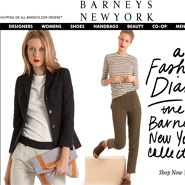- About
- Subscribe Now
- New York,
January 26, 2012

NEW YORK -- Ecommerce is continuing to increase about 17 percent year over year and will likely account for $200 billion in sales in 2012, according to a presentation at the Women’s Wear Daily Digital Forum.
Based on holiday sales from 2011, retailers should be looking to spend more of their budget on Internet promotions and start earlier than they would for retail store campaigns. MasterCard believes that in January online sales may take a 20 percent share of total retail sales as the weather keeps people from venturing to bricks-and-mortar stores.
“You are looking at really substantial numbers here,” said Michael McNamara, global solution leader at MasterCard Spending Pulse, New York. “[Online] is where the money is, it's where the growth is and it's where your strategies and online dollars should be, both last year and for the next few years.
“The trends I’m monitoring right now don’t seem to be slowing down," he said. "In fact, they seem to accelerating in many places.”
Holiday cheers
Holiday sales for 2011 were uneven with extreme peaks and valleys, according to Mr. McNamara.
Due to the nature of online, sales began increasing on Nov. 1 and peaked on Black Friday weekend.
On Black Friday alone, retail ecommerce sales have seen a 29 percent increase over the past two years.
In fact, the highest ecommerce sales in women’s apparel were seen Nov. 28-30 and Dec. 6 in last year.
Additionally, online sales remained strong from the beginning of November through the first two weeks of December.
After the middle of December, online sales slowed in the retail industry.
While the same slow-down is generally not seen in bricks-and-mortar stores, where consumers usually run for last-minute shopping, online shoppers tend to shop earlier to allow for shipping.
Therefore, luxury marketers should be looking to start holiday Internet campaigns that drive to ecommerce platforms as early as Nov. 1, according to Mr. McNamara.
Snow means sales
Ecommerce will be strong throughout the winter months, likely accounting for 20 percent of total sales in January.
Consumers do not like to, or in many cases, simply cannot go to bricks-and-mortar stores due to winter weather conditions. This will likely help spike ecommerce sales in the northern United States, claims Mr. McNamara.
Additionally, there is a direct correlation between rising gas prices and ecommerce sales.
As the price of gas continues to go up, and MasterCard suspects that it will reach $4 per gallon by Memorial Day weekend, ecommerce will continue to take a larger share of total sales.
Therefore, the real focus of all promotional activity over the next few months should be driving consumers to an ecommerce store.
However, ecommerce is not only increasing its share of sales during the holiday season and winter months. It continues to thrive throughout the year.
In fact, in the depths of the recession in 2008, there was not a single day that exceeded $1 billion in total ecommerce sales, according to MasterCard.
Along with that, in 2009 there were three days that saw sales of more than $1 billion and in 2010 there were seven days.
Last year advanced even further when there were 17 days that saw online sales crossing $1 billion.
Luxury brands that ignore the numbers pertaining to ecommerce risk the chance of losing sales to third-party retailers. In fact, the luxury and high-end industries should be preparing for a few headwinds in 2012, according to Mr. McNamara.
“When we look at luxury growth momentum for 2012, we look at the stock market performance because that [often] echoes into luxury spend,” Mr. McNamara said.
“Wall Street bonuses down and Europe [when we are] in or almost in a recession could hurt East Coast tourism and cause some problems for luxury retailers,” he said.
Final Take
Kayla Hutzler, editorial assistant at Luxury Daily, New York
Share your thoughts. Click here